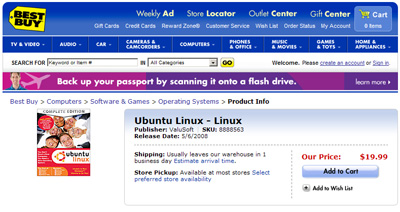Archive for the ‘Technology’ Category
Posted by //
Sean
Date //
Jul 17, 08 - 10:42 am
Categories //
Software
Technology
Wireless
Comments Off on Opera Launches Latest Mobile Browser Beta
Today marked the official launch of the Opera Mobile 9.5 beta browser. I have been waiting for this beta program for a long time now, and as soon as the beta became available, I rushed to the Opera web site to download the browser.

From today’s press release, we know that Opera Mobile 9.5 beta now defaults to page overview mode, allowing the user to view the entire Web page and instantly recognize the Web site. With panning and zooming options, the user is able to focus on specific page content. Opera also introduced a new user interface for easier navigation.
Here’s a list of some of the improvements you’ll notice over Opera Mobile 8.65:
- Faster – Opera Mobile 9.5 beta continues this fine tradition with improved performance over Opera Mobile 8.65.
- Pan and zoom – Just like Opera Mini, Opera Mobile 9.5 beta defaults to full Web page viewing and allows users to pan and zoom into their desired content easily.
- Improved user interface – Opera has completely renovated its mobile UI. Cleaner and more intuitive, the new UI is designed for quick and easy navigation.
- Opera Dragonfly – Use your Opera desktop browser to debug sites on your mobile phone through the Opera Mobile 9.5 debug menu.
- Improved standards support – Opera Mobile 9.5 is the most standards compliant browser available, and the company remains steadfast in its commitment to make the Web accessible for all.
- Save pages and/or images – With a click, simply save pages to your phone.
This last point is a nice touch to add. I often want to be able to save images I see on the Web. Being able to do so on your phone (where I happen to spend a lot of time browsing) is an unexpected added bonus.
Posted by //
Sean
Date //
Jul 10, 08 - 10:43 am
Categories //
Open Source
Software
Technology
Comments Off on How Much Linux Can You Get For $20?
Most of us reading this are probably accustomed to the idea of getting Linux for the cost of an opinion about the weather — in other words, nothing. But now Ubuntu, arguably the most visible of Linux distributions, is hitting store shelves at Best Buy for the practically impulse-buy cost of $19.99 USD.
Why pay? Two reasons: One, you get printed documentation — something people have increasingly lamented the loss of, although the cost of printing in general (and the search ability of electronic files) has pushed paper docs aside.
The other, and more significant reason, is sixty days of unlimited tech support courtesy of Canonical. Two months is a fairly decent margin of time for someone to install Ubuntu and work their way through most showstopper issues, and the most recent Ubuntu comes with a very nice gamut of tools to make migration and dual-booting a lot easier than it usually is.
The price is definitely right. The last time I saw boxed Linux on the shelf of my local Best Buy, it was SuSE, and it sported a pricetag of almost $100.00 USD (A quick search of Best Buy’s site shows they don’t even keep SuSE in stock anymore; not much of a surprise, there.)
I’d love to not only see this take off, but spawn some competition in the same space — say, perhaps from an outfit that uses the same pricing model but uses Fedora or even OpenSuSE as their base distribution.
Posted by //
Sean
Date //
Jul 10, 08 - 6:42 am
Categories //
Apple
Software
Technology
Wireless
Comments Off on iPhone Firmware 2.0 Is Available
Yep, you read that correctly. It isn’t officially available through iTunes yet, but the file is out there and can be downloaded and installed on your iPhone.
In order to snag the file to update your Apple iPhone’s firmware, go to MacRumors for the download.
MacRumors reports:
“In order to install the firmware, you will have to do it manually by pressing the Option key when pressing the ‘Check for Update’ button in iTunes. Then select the .ipsw file manually. If for some reason your download is a ‘.zip’ file, rename it to ‘.ipsw’ before proceeding.”
The Apple iPhone firmware update is a 225 MB file, so it’s going to take a while. You can also grab the iPhone1,2_2.0_5A347_Restore.ipsw firmware from here. Enjoy.
Posted by //
Sean
Date //
Jul 3, 08 - 4:23 pm
Categories //
Google
Search
Technology
Comments Off on Google Adds Privacy Link To Home Page
Last month, a handful of privacy groups urged Google to add a link to its privacy policy on its home page, in accordance with California law.
Google said it interpreted the law differently.
Google resisted doing so in part because every bit counts when determining how quickly its home page loads, given that load speed and user satisfaction are strongly related.
The company probably also wanted to avoid giving outsiders the idea that they can force design changes by complaining.
In a blog post, Marissa Mayer, VP of search products and user experience, said that Google co-founders Larry Page and Sergey Brin would agree to the change only if the number of the words on the home page (28) remained unchanged. So the word “Google” was dropped because it was implied.
“Today we’re making a homepage change by adding a link to our privacy overview and policies,” said Mayer. “Google values our users’ privacy first and foremost. Trust is the basis of everything we do, so we want you to be familiar and comfortable with the integrity and care we give your personal data. We added this link both to our homepage and to our results page to make it easier for you to find information about our privacy principles.”
So as we can all see, Google replaced the unnecessary “©2008 Google” copyright notice at the bottom of its home page with a privacy link.
Though the copyright symbol and date remain, the bottom text now reads “©2008 – Privacy.”
Well done, Google.
Posted by //
Sean
Date //
Jul 2, 08 - 8:52 am
Categories //
Open Source
Technology
Web
Comments Off on The GPLv3, One Year On
It’s been a year since the GPLv3 was introduced to the open source world — so how’s it doing? That’s the subject of two surveys currently being conducted to track open source license usage and conversion.
The first survey, conducted by Black Duck Software, shows the GPLv3 coming it at No. 7 out of the top 20 open source licenses used amongst projects polled.
Not surprisingly, the GPLv2 filled the top slot by a gigantic margin — 57.81% — while the GPLv3 had a 1.82% share.
That’s still not too bad for a license that was only introduced a year ago; the same survey puts the Apache License at 2.77% and the Mozilla Public License at 1.29%.
The second survey, courtesy of Palamida, also features some detailed quotes from various software outfits about GPLv3 adoption.
Some fairly famous names are in that list — SugarCRM’s Community Edition and Samba, for instance, have adopted Version 3, although there are still plenty of big names sticking with what they have.
I’m not terribly surprised by this, since I didn’t figure the GPLv3 was going to be an automatic upgrade for most people.
One thing that would be useful to know, although admittedly not the easiest thing to harvest, is activity statistics about the projects in question — maybe by using the activity stats from Sourceforge if the project’s hosted there.
This would give us some idea of the degree of usage or participation for each project. It’s one thing to say “2,800 open source projects use the GPLv3,” but what percentage of those 2,800 projects are, say, part of the top 100 or even 500 projects at Sourceforge?
Finally, a quick and admittedly unscientific glance at the lists of projects in both surveys shows a healthy mix of project types — a little of everything under the sun, from what I can tell.
It’ll be interesting to see where things stand in another year — or even by the end of this one.
Posted by //
Sean
Date //
Jul 1, 08 - 6:33 pm
Categories //
Security
Software
Technology
Comments Off on Hey You. Yeah, You: Patch Your Web Browser
Roughly 59% of Internet users use the latest, more secure Web browsers, according to an examination of what version Web browser, down to the patch level, people are using.
That means about 576 million Web surfers leave themselves vulnerable to attack. You might just (not) be surprised by who doesn’t patch.
The study, published today, was conducted by the Swiss Federal Institute of Technology, Google, and IBM Internet Security Systems.
The researchers found that no matter how quickly browser and plug-in vendors create patches to fill security holes, it could be months before a large segment of the Internet population will apply those patches.
While I wasn’t surprised to see 83.3% of Firefox users having applied the most recent patches, the same can’t be said for Opera users, because only 56.1% of those users keep their browser up to date.
One would think that both Firefox and Opera users would be more technically savvy than the average user, thereby more prone to patch. Unlike Internet Explorer users, where less than half, at 47.6%, bother to apply the most recent software updates.
The study examined search and Web application log data from Google to ascertain what version of browsers, including patch levels, are used.
For Internet Explorer, the researchers culled data from Danish security firm Secunia’s Personal Software Inspector.
